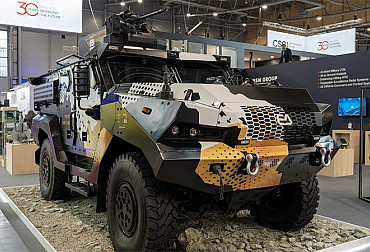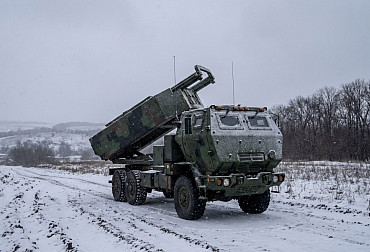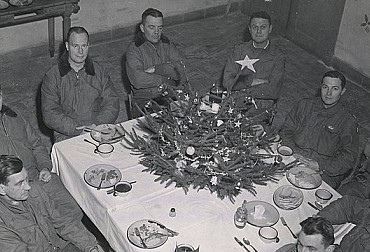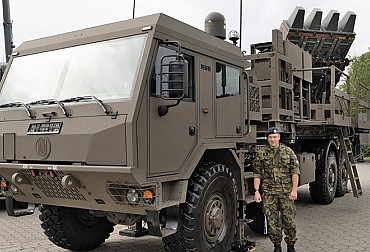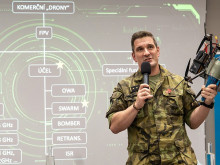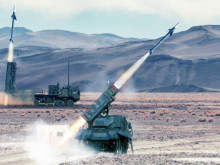Fire Support Vehicles – possible solutions for the Czech Armed Forces
Recently, in the context of the Ukrainian war and the overall deterioration of the security situation in Europe, but also in connection with the upcoming acquisition of new IFVs and the ongoing delivery of Leopard 2 tanks, discussions have arisen on how to further increase the combat capabilities of the Czech Army. A significant role in this is of course also played by the gradually increasing defence spending, with the Ministry of Defence finally having relatively enough money for the necessary purchases. A frequently mentioned way to increase the capabilities of the ground troops of the Czech Armed Forces is the so-called fire support vehicles, i.e. vehicles with a turret with a large-calibre 105-120 mm cannon on the chassis of tracked or wheeled armoured personnel carriers.
These considerations are to some extent justified, if we take into account that the Czech Army will still have relatively low numbers of weapon systems even after the aforementioned acquisitions of new equipment. There should be 210 new tracked IFVs, and the Czech Army should have only one battalion of tanks. Thus, the possible acquisition of fire support systems that would share a chassis with the upcoming tracked armoured vehicles or the already operating Pandur II wheeled armoured vehicles is logical. Still, the question is what kind of fire support systems the Army actually needs.
Tracked fire support vehicles
The most frequently mentioned in various discussions are tracked fire support vehicles, sometimes also referred to as light tanks. These vehicles are very similar to the earlier light tanks, and in many ways even surpass them. The modern vehicles, thanks to their massive firepower, consisting of 90-120 mm guns, are equal to full-sized MBTs, from which they differ only in terms of lower armour protection and, as a result, significantly lower weight. Therefore, these vehicles were mentioned at the time as a possible replacement for the T-72 tanks.
Within the category of tracked fire support vehicles, a number of different types have been developed. Among the Western vehicles, one can mention, for example, the CV90105/120 vehicles, as well as the very similar ASCOD 2 105/120 type. In particular, the CV90 105/120 type is often mentioned in connection with the upcoming acquisition of the CV90 MkIV for the Army. However, it is questionable whether such vehicles would really be the right solution for the Czech Army. It must be said that fire support vehicles based on tracked IFV are in many ways a controversial category with a number of shortcomings. These are mainly due to the fact that the tracked chassis of the IFV is primarily designed for transporting troops and not for carrying a turret with a large-calibre gun. For this reason, fire support vehicles have a less than optimal use of internal space. In some cases, such a vehicle does not even have an efficient ammunition storage location and is therefore only able to carry a small number of rounds (10-12) placed in the turret. While there have been designs that carry a higher ammunition supply in the former landing gear compartment, even this solution is not ideal. The war in Ukraine and the experience with the deployment of T-72 tanks (which also have inadequately stored ammunition) clearly show how important the correct storage of ammunition in an armoured vehicle is.
The fact that, e.g. the already mentioned CV90105/120 type has been offered by the manufacturer for many years (CV90105 TML since 1993, CV90120 since 1998), yet no army has yet purchased these vehicles, also speaks volumes about the proliferation of fire support vehicles based on tracked IFV. ASCOD 105 vehicles were purchased by Thailand a few years ago in a small number of 15 units, and ASCOD 2 120 vehicles are currently being purchased by the Philippines, but also in a limited number of 20 units. A fire support vehicle equipped with the 105 and 120 mm guns was also developed based on the German Marder IFV, but has so far failed to find a single customer, despite a massive advertising campaign by the manufacturer. It must be said that other designs such as the joint Belgian-South Korean (CMI Defence and Hanwha Defence) K21-105 vehicle project are doing similarly. Even these vehicles have not yet reached series production.
 Picture: CV90105 | BAE Systems Hägglunds
Picture: CV90105 | BAE Systems Hägglunds
It is therefore questionable whether this type of vehicles would be beneficial for our army in terms of possible integration into the structure of the Czech Armed Forces, their role and the tasks that these vehicles should perform. Today, the Army has only one heavy unit – the 7th Mechanised Brigade (7. mb), into whose structure the new IFVs will be incorporated in the coming years. This brigade will also have a tank battalion equipped with German Leopard 2 tanks, which will be its main force. Hypothetically, it would then be possible to incorporate fire support vehicles with large-calibre guns into the structure of individual battalions. In this case, however, the individual mechanized battalions would become significantly "heavier", and logistics would be more challenging (at least due to the provision of additional ammunition).
 Picture: ASCOD 42 fire support vehicle with Hitfact 120 mm turret | General Dynamics European Land Systems
Picture: ASCOD 42 fire support vehicle with Hitfact 120 mm turret | General Dynamics European Land Systems
Wheeled fire support vehicles
More interesting or more beneficial for the Czech Armed Forces could be a category of fire support vehicles constructed on the basis of wheeled chassis, sometimes called wheeled tank fighters. This category became widespread especially in the 1990s and at the turn of the century, i.e. at the time of major expeditions and foreign missions. For these missions, heavy tracked equipment in the form of tanks or tracked APCs were not suitable, and conventional wheeled armoured personnel carriers, especially in the 8x8 version, proved more suitable. However, practice also showed that these vehicles needed to be equipped with sufficient firepower. Thus, the wheeled types were first equipped with 30-40 mm guns, and then with guns of higher calibre, i.e. 90-105 or even 120 mm, to compensate for the absence of tanks in the expeditionary units.
This category of wheeled fire support vehicles is still quite widespread in the world. One could even say that there is no type of wheeled armoured personnel carrier that does not have a version equipped with a large-calibre gun. For example, the Belgian army has large numbers of Mowag Piranha vehicles equipped with the 90 mm cannon.
 Picture: Mowag Piranha IIIC DF 90 | MoD Belgium
Picture: Mowag Piranha IIIC DF 90 | MoD Belgium
The situation is somewhat different for the Italian Army, which originally had B1 Centauro gun carriers with 105 and 120 mm cannons, but has also included in its armament wheeled IFVs based on this tank destroyer. Fire support vehicles based on wheeled armoured vehicles have become even more widespread in various developing countries, including regional powers such as Saudi Arabia, etc.
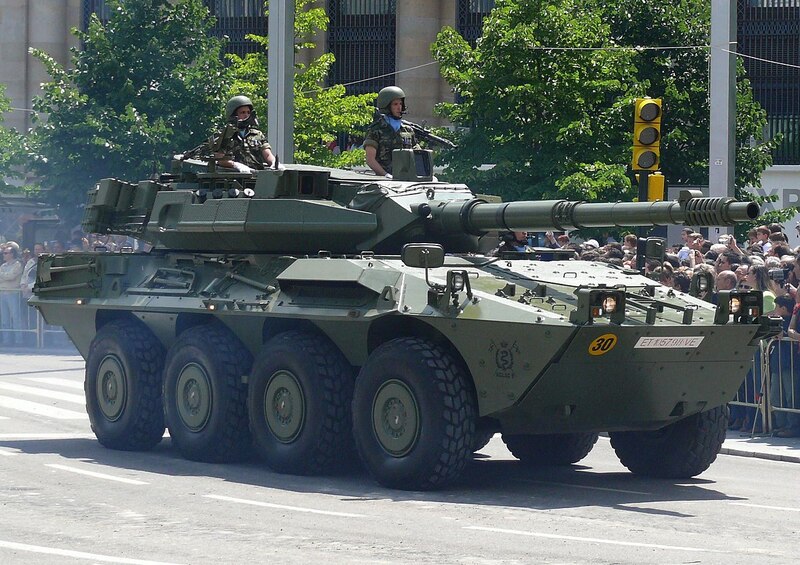 Picture: B1 Centauro with 105mm gun | Wikimedia Commons / Public domain
Picture: B1 Centauro with 105mm gun | Wikimedia Commons / Public domain
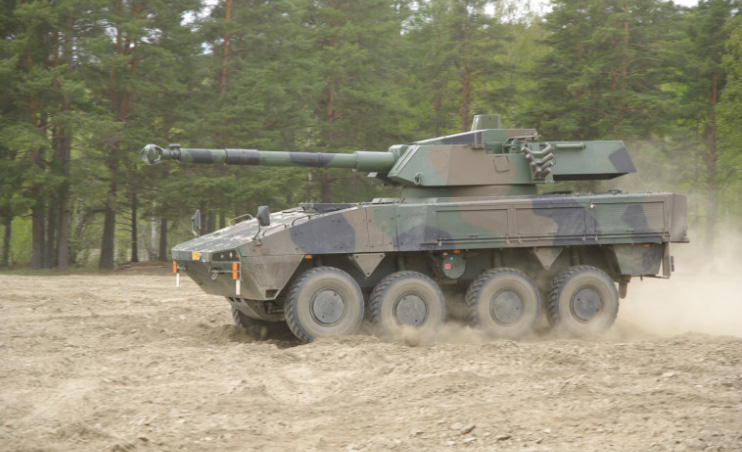 Picture: Patria AMV with John Cockerill CT-CV 105HP turret | John Cockerill
Picture: Patria AMV with John Cockerill CT-CV 105HP turret | John Cockerill
It must be said that this category also has its negatives, which are de facto the same as in the case of tracked fire support vehicles. Wheeled fire support vehicles also have less than adequate ammunition storage, but in the case of the wheeled platform this is somewhat less of an issue.
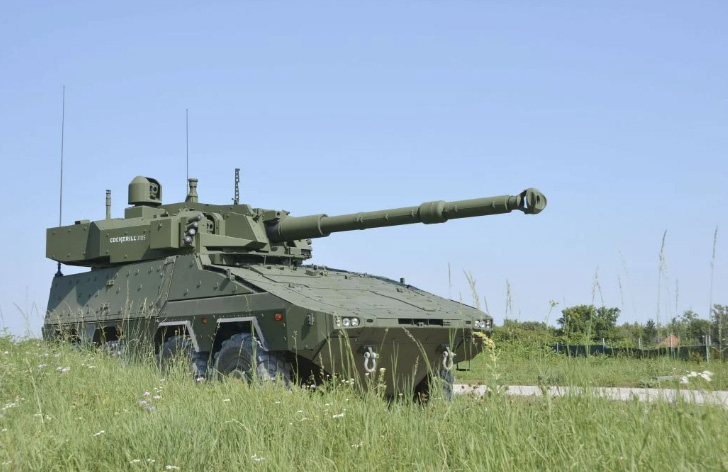 Picture: Boxer vehicle with John Cockerill C3105 turret with 105mm cannon | KMW
Picture: Boxer vehicle with John Cockerill C3105 turret with 105mm cannon | KMW
As mentioned above, wheeled fire support vehicles would conceptually fit into the AFV, its structure and its armament much better than tracked vehicles, if necessary. First of all, it can be mentioned that the Czech Armed Forces already has a suitable carrier for such a fire support vehicle – the Pandur II CZ 8x8 platform, which has been serving reliably in the Czech Armed Forces for many years. Pandur II vehicles are sometimes accused of being an outdated technology. Yes, the newest wheeled armoured personnel carriers, such as the Israeli Eitan type weighing about 35 tonnes, are indeed somewhere else than the relatively light Pandurs, but on the other hand, it should be noted that even lighter types of wheeled armoured personnel carriers have proved their usefulness, and there is still interest in them in the world. It is also important to note that Pandur II vehicles are now fully produced by the domestic armaments industry, Tatra Defence Vehicle, which, incidentally, also manages to export Pandur IIs. Moreover, the war in Ukraine (and before that the covid crisis) clearly shows the importance of building up a domestic arms industry in order to reduce dependence on foreign supplies. Moreover, supplies from a domestic supplier have a positive benefit for the treasury. It is for these reasons in particular that the Army plans to increase the number of Pandur II armoured personnel carriers. The specific contract has not yet been concluded, and it has not yet been defined how many new Pandur IIs the Czech Army intends to acquire, but it is likely that the increase in the number of vehicles will actually take place, and part of this increase could be the acquisition of fire support vehicles.
The Pandur II armoured personnel carriers are also sometimes accused of having relatively weak armament, consisting primarily of the Mk44 Bushmaster II 30 mm cannon, using 30x173 mm ammunition (the same calibre as the new CV90 MkIV tracked IFV). However, some modern wheeled armoured personnel carriers, or IFVs, use the higher calibre 35, 40 mm cannon, and there are also vehicles with 57 mm cannon. However, this criticism is only partially justified. If we look into the armament of the world's armies, we find that 30 mm cannons (of various types of ammunition, the Russian 30x165 mm calibre also has its place) are still the most widespread in the world. Moreover, the experience of recent conflicts has shown that the 30 mm calibre is sufficient, and guns of this calibre can effectively perform the tasks that are imposed on wheeled armoured personnel carriers.
Video: Simulation of the effect of a 30mm round (3UBR8 APDS) penetrating the side armour of a T-72 tank / YouTube
Thus, rather than increasing the calibre of the cannon for all vehicles, it seems to be a much better solution to keep the 30 mm calibre for wheeled armoured personnel carriers or wheeled armoured personnel carriers and to supplement these vehicles with a heavier version equipped with a large-calibre cannon.
90 mm or 105 mm?
If the Army decides to acquire wheeled fire support vehicles equipped with a large-calibre cannon, the question is what calibre the cannon should be. The fact is that there is not yet a version of the Pandur II vehicle with a 120 mm calibre gun, so realistically one can only choose between 90 and 105 mm calibre if necessary.
Of course, 90 mm guns have lower performance compared to the 105 mm calibre, but on the other hand, experience from various conflicts suggests that even these guns are sufficient. Above all, the 90 mm calibre guns have proved to be well suited for fire support tasks, for destroying various fighting positions, etc. In particular, one can point to the excellent experience of the Belgian Army, which has 90 mm guns fitted to its Piranha III vehicles, but also to the experience of the French Army and a number of developing countries using ERC-90, AML-90, etc. vehicles. It is also an important fact that there are a number of different types of ammunition in the 90 mm calibre.
The 105 mm guns have a higher performance and a higher effect on the target. However, this power is not always used effectively, which is why 90 mm calibre cannons continue to retain their place. The 105 mm cannon is particularly suited for fighting armoured targets – even tanks. They can even make their way into combat with such tanks as the T-72. Similar to the 90 mm calibre, the advantage is then the existence of a wide range of modern, readily available and relatively cheap ammunition, standardised in NATO. A version of the Pandur II armed with the 105 mm cannon has already been designed and tested by the manufacturer in the past, so it would be relatively easy to start serial production and eventually introduce such a vehicle into the armament of the Czech Armed Forces. However, it would probably not be a problem for the manufacturer to develop a variant with a 90 mm gun if necessary.
Conclusion
Although the units of the 7th Mechanised Brigade equipped with tracked IFVs do not need a version of the fire support vehicle to a large extent (except for self-propelled mortars), the 4th Rapid Deployment Brigade, which is currently equipped with Pandur II 8x8 armoured personnel carriers, lacks a fire support vehicle. Although the army envisages the introduction of self-propelled mortars in the future as part of fire support, specialised versions of wheeled vehicles carrying a large-calibre cannon seem to be another possible solution. The experience of asymmetric conflicts has then shown, somewhat surprisingly, that it is advisable to have such vehicles already at battalion level, rather than as a separate unit at brigade level. It is then a question how many such fire support vehicles the Army would need. A possible solution seems to be to have a fire support unit with 10 to 14 vehicles in each battalion.











